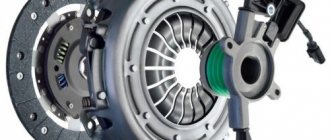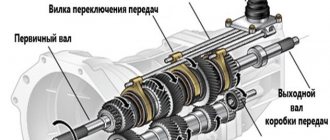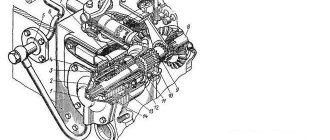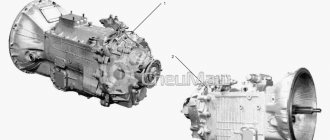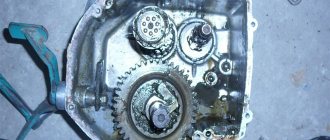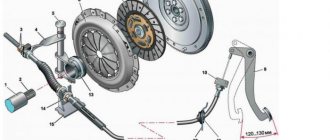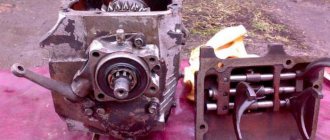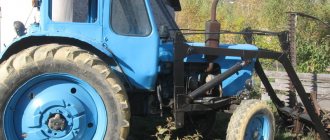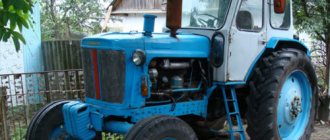Features of the double-disc clutch device
On many all-wheel drive wheeled and high-speed tracked vehicles, a friction dry double-disc, permanently closed clutch with peripherally located pressure springs is installed.
The features of such a clutch, installed on KamAZ, Ural and other vehicles, are the presence of a device (which does not require adjustment during operation) for automatically setting the middle drive disk in the middle position when the clutch is disengaged, a heat-resistant lining of the driven disk with a long service life and a certain The shape of the casing ensures fixation of the pressure springs.
The leading parts of the clutch include the flywheel 27, the middle drive disk 2, the pressure disk 4, the casing 77 with 3 bushings and bolts 19. The middle drive and pressure disks each have four pins on the pressure surface, which fit into grooves on the cylindrical surface of the flywheel and are transmitted to the drive drives torque from the engine. At the same time, the possibility of axial movement of disks 2 and 4 is provided.
The driven parts include two driven disks 7. The driven disks are steel, equipped with friction linings 22 made of asbestos composition; they are connected to their hubs through torsional vibration damper discs 24 with springs 25 and friction rings 26.
The driven disc hubs are mounted on the splines of the clutch driven shaft 23, which is also the drive shaft of the gearbox (or front gear divider).
Between the casing 17 and the pressure disk 4, pressure springs 16 with heat-insulating gaskets 18 are installed, under the action of which the driven disks are clamped between the pressure and middle driving disks and the flywheel with a total force of 10,500... 12,200 N (1050... 1220 kgf).
The clutch release device consists of release levers 6, connected at the outer ends to the pressure plate 4, and in the middle part - with support forks 5, which are installed in the casing 17, a spring 7 with a loop 9, a thrust ring 14 of the release levers and a release clutch 72 with a bearing 10, a pull-out spring 77 and a lubrication hose 8 installed on the cylindrical part of the bearing cover of the transmission drive shaft, and a release fork 75 installed on the roller 75 in the clutch housing 20.
Rice. Double-disc clutch device
The middle drive disk 2 has a lever mechanism 27, which automatically sets disk 2 to the middle position when the clutch is disengaged, freeing the front driven disk 1. Thus, there are gaps between the drive and driven disks of the clutch when it is completely disengaged, which ensures clean disengagement of the clutch.
Scheduled replacement after a certain mileage or service life
The service life of the clutch depends on the conditions in which it is operated. The clutch life depends not only on the quality of the parts, but also on the driving style. Participation in racing, abrupt starts from a standstill at high speeds and incorrect clutch adjustment have a detrimental effect on its performance.
If you follow all the rules, then a planned replacement will need to be carried out after 100 thousand km. mileage If you violate the basic operating rules, then replacement will have to be carried out after 50 thousand km.
Signs of clutch problems will be noticeable while the vehicle is in use. The exact location of the breakdown can be determined after diagnostics. If you carry out scheduled repairs and replacements in a timely manner, you can avoid serious damage, the elimination of which requires large financial investments.
In mechanics, a clutch is a mechanism whose operating principle is based on the action of sliding friction. Often the term "clutch" is used to refer to one of the components of a vehicle's transmission that is used to connect the engine flywheel to the transmission. Depressing the clutch pedal temporarily disconnects the power transmission from the engine.
The clutch mechanism is necessary so that you can start smoothly from a standstill, without jerking. The speed of the car begins to increase only at a certain minimum number of engine revolutions. The clutch is also used when it is necessary to match the vehicle speed and the engine crankshaft speed, that is, it ensures smooth transmission of torque from the engine to the gearbox and, if necessary, at some point completely disconnects the manual transmission gears from the engine transmission mechanism.
There are several different types of clutch. Often these are one, two or more friction discs, pressed tightly against one another or against the flywheel using springs.
When the driver presses the pedal, the clutch discs are disconnected, and an air gap appears between them; the clutch is disengaged at this moment, and torque is not transferred from the engine to the gearbox. If the pedal is released, the clamping springs return the discs to their initial position, and they again come into close contact; the torque from one drive disc is transmitted through the action of friction to the driven disc.
The clutch is one of the very important components of a car. Various types of these mechanisms are classified according to the control method, the type of friction operating in this case (dry friction or wet friction), the number of disks, and so on. As engine power increases, torque also increases; accordingly, double-disc clutch systems are used, which have a longer service life.
Sooner or later, clutch discs wear out and require replacement. Clutch malfunctions can lead to failure of other parts of the car, for example, gears of the gearbox mechanism, or even to the inability to start the car on the road.
Operating principle of a double-disc clutch
The clutch transmits the greater the torque, the larger the area of its friction surfaces, the pressure force of the springs and the coefficient of friction of the friction linings. The friction coefficient depends on the material of the surfaces, and its value is limited. The spring pressure cannot be too great, as this will make it difficult to disengage the clutch; in addition, the pressure on the rubbing surfaces may be excessively high, and their dimensions are limited by the dimensions of the flywheel. As a result, sometimes to transmit large torques in cars, a clutch is used not with one, but with two driven disks.
The driving part of a double-disc clutch consists of a flywheel with six fingers, on which the clutch housing is mounted and the drive discs are put on. All parts of the clutch drive rotate together as one unit. A heat-insulating ring is attached to the rear drive disk with screws, into which the springs rest.
The driven part of the clutch includes two driven discs with hubs and the input shaft of the gearbox, on which the driven discs are mounted on splines.
Promotional offers based on your interests:
Rice. 1. Double-disc clutch: 1 - flywheel; 2 and 4 — driven disks; 5 — driving disks; 6 - casing; 7 - pedal; 8 — shutdown lever; 9 — clutch release; 10 - fork; 11 - spring; 12 - finger; 13 - gearbox input shaft
Adjustment instructions
The Lada Priora is equipped with a clutch cable with a ratcheting mechanism. The cable is backlash-free and does not require adjustment, but manufacturers recommend this be done during every maintenance.
Clutch cable
To adjust the cable on the Lada Priora, you need to prepare a screwdriver and a ruler. The procedure then consists of the following steps:
- To perform work, you must open the hood.
Engine compartment of Lada Priora First, you should disconnect the mass air flow sensor and remove the air filter.
Engine compartment without air filter
- After this, a cable will be visible, at the end of which there is a plastic clip.
- Before adjustment, it is necessary to set the cable to its original position: overcoming the resistance of the spring, push the cable clamp forward until it stops in the direction of movement of the car.
- This clamp should be pulled towards you and the distance between it and the plug should be measured, it should be 27 mm.
We measure the distance using a ruler - The distance is adjusted by turning the tip counterclockwise. In this way, an increase in distance can be achieved.
- Twist the clamp until the distance is 27 mm. Accuracy is very important here.
- Now you can release the cable and place it in the fork.
- After completing the steps, you need to get behind the wheel and press the pedal three times until it stops.
- Then again you need to measure the distance, it must be exactly 27 mm, otherwise we adjust until the desired distance is achieved.
- Next, you should insert the tip into the groove of the mechanism fork and release it. Thanks to the spring, the tip driver clamp is installed without any gap.
- After adjusting the cable, you need to return everything to its place, start the engine and check the operation of the mechanism.
After adjustment, the clicks disappear and the clutch release pedal operates softer.
Clutch pedals
When the clutch pedal travel is large, the clutch is not completely disengaged, so it still comes into contact with the flywheel of the power unit. When the stroke is low, the driven disk does not turn on completely, which leads to slipping and loss of torque.
You should measure your pedal stroke if the following symptoms occur:
jerks appear when starting to move; noise and shock when shifting gears; the pedal gets stuck.
The symptoms described indicate that the mechanism requires adjustment. You can diagnose its operation on Priora yourself. To do this, start the engine, slowly release the PS and start moving. If, when the PS is released, the car immediately begins to move, this means that there is no free play. If the car does not budge even with the pedal fully released, then its travel exceeds the norm. The brake pedal should be at the same level as the brake pedal. In this case, its full stroke will be in the range of 125-135 mm. Fluctuations up to 160 mm are possible.
We measure the free play of the pedal
When making adjustments, loosen the first cable adjusting locknut located in the engine compartment on the bracket.
Locknuts for adjusting free play
By tightening the second locknut, the distance and stroke of the PS are adjusted. Thus, the desired result is achieved. After completing the procedure, the first locknut is tightened.
If you adjust so that the brake pedal is located above the brake pedal, then the clutch will barely leave the floor. If it is lower, it will set almost at the very end. If the PS is located too high, the basket wears out faster. The ideal option is that the brake and clutch pedals should be at the same level.
In order to extend the life of any mechanism, you should use it carefully. You should not constantly keep your foot on the PS; it is better to place it on the left on the floor. During each technical inspection of the Lada Priora, it is recommended to monitor the free movement of the PS and the clarity of gear shifting and, if necessary, make adjustments.
How does the clutch work?
Let's look at how the clutch works. Today, a dry, single-disc, constantly engaged clutch has become widespread. That is, it turns out that when the car is parked, or during constant driving (at a certain constant speed), the clutch is always engaged by default and works as a connection between the gearbox (manual or automatic) and the engine flywheel. It turns out that the principle of operation of the clutch is to constantly connect the flywheel of the power unit and the gearbox, and, if necessary, separate them.
Let's continue answering the question of how the clutch works. Let's see what happens when the clutch pedal is fully depressed. When the driver presses the clutch pedal, the force is transmitted through the drive to the release bearing, thus transmitting force to special release springs. And the entire working surface of the clutch is pressed away from the clutch disc. By releasing the disc on the input shaft, the gearbox stops rotation while the power unit continues to operate.
In conclusion, answering the question - how the clutch works, you should tell us what happens when the pedal is not pressed. When the clutch is in the operating positions, the splined coupling receives the input shaft. Under the influence of the release springs on the clutch pressure plate, full contact occurs, in which the flywheel is pressed against the clutch disc. Thanks to this, the torque generated by the engine is completely transmitted via the clutch disc to the gearbox.
The principle of operation of the clutch for dummies can be reduced to the following - as a result of the clutch, the working surfaces of the three components are tightly pressed against each other:
- Flywheel;
- The lining of the clutch disc itself.
- Clutch basket pressure surfaces
The principle of operation of the clutch, which is constantly disengaged, is exactly the opposite of that described above. However, this type of clutch is not widely used, and therefore we will not dwell on a more detailed consideration of this issue.
The principle of operation of the clutch is that at certain moments it does not work, while the clutch is constantly engaged and works together with the flywheel and gearbox.
Operating principle
The smoothness of switching on/off speeds is ensured by the sliding of the constantly rotating drive disk (which is attached to the crankshaft of the internal combustion engine) relative to the driven disk, which is connected through a spline to the gearbox.
The muscular force exerted by the driver on the clutch pedal is transmitted to the mechanism mechanically (using a lever or cable mechanism) or through a hydraulic drive.
The pedal is connected to the clutch fork, which moves the release bearing, which, by pressing on the ends of the petals of the diaphragm spring, stops its pressure on the pressure plate, and it, in turn, releases the driven one. At this time, the engine is disconnected from the transmission.
Having engaged the desired gear of the gearbox, the driver releases the clutch pedal, and the fork stops acting on the release bearing, which stops acting on the spring. The pressure plate presses the driven one against the flywheel, and the engine is again connected to the transmission.
When the clutch is engaged, torque is transmitted from the crankshaft to the flywheel, then to the clutch housing and, through the leaf springs, to the drive (pressure) plate. From the flywheel and the driving pressure plate, using friction, torque is transmitted to the driven disk clamped by them, whose hub is equipped with a splined connection to the drive shaft of the gearbox.
If you sharply release the pedal when engaging the clutch, the driven disk will also sharply and forcefully press against the drive disk (flywheel), braking it to such an extent that the engine will stop (stall) - i.e., the clutch will act as a braking mechanism. That is why the clutch pedal must be released smoothly and gradually after the discs begin to engage. How smoothly and gradually depends on the design of the clutch drive.
Operating principle of a double-disc clutch
The operating principle of different types of clutches is similar, as is their design. However, they function differently. Let's look at how a double-disc clutch works.
First of all, you should pay attention to the fact that a double-disc clutch is always used on heavily mechanically loaded vehicles. That is, when there is a heavy load on the car’s power unit and a stronger connection between the engine and the clutch is needed.
Such vehicles can be:
- Armored vehicles;
- Trucks;
- Heavy motorcycles;
- Sports cars.
A double-disc clutch works as follows: with the help of a release bearing, a force is generated that is transmitted to the release levers, which pull back the pressure plate. Then, the pressure disk is disconnected from the first driven disk, and the springs are pressed out. These springs disconnect the intermediate drive disk, which in turn moves away from the second, the friction disk. This occurs due to the fact that different release springs are used. When the reverse movement occurs, the release springs evenly press the intermediate disk against the second driven disk and press the pressure disk against the first driven disk. To ensure uniform movement of the pressure disks, studs are made that are screwed into the flywheel. Pressure or pressure plates move along these studs. The clutch basket itself is attached to these same studs, and release springs are also attached to them.
Release bearing
Replacing the clutch cylinder: process and recommendations for choosing a part
There are two types of bearings:
- Mechanical
- Hydraulic
Mechanical
It is located inside the coupling. It has mounts for the fork. The bearing itself sits on the gearbox input shaft. This spare part is sold assembled. You can find specimens in plastic sleeves. There were no complaints from car service specialists about them. Therefore, there is not much difference, either in metal or plastic.
Roller or ball type bearings are used. They are used in cable and hydraulic drives. In cable systems, force is transmitted from the pedal to the bearing using a cable. A combined type is possible, where two cylinders are used - the main and the working.
The pedal pressure is transmitted to the master cylinder. By means of a hose and tubes filled with brake fluid, it pushes the piston into the working cylinder due to the compression force in them. Which interacts with the clutch fork. It moves the bearing clutch.
Hydraulic
There are also hydraulic ones, but they are rarely used. The reason is the unreliability of the design. Over time, the rubber seals wear out and begin to leak fluid. Because of this, work efficiency decreases, and it needs to be replaced. Difference from mechanical:
- No plug
- The hydraulic bearing does not move along the gearbox input shaft. Only the piston moves, with a mechanical type bearing attached to it.
- Liquid is used as a working medium. It is located in his body.
Such bearings are used with hydraulic drives. Such systems also have cylinders filled with liquid. But the force is transmitted not to the piston of the working cylinder, but to the bearing itself.
How does the clutch release work?
I said that the entire clutch mechanism is hidden under a casing (basket), which rotates at the same speed as the crankshaft. In order to transfer force from the pedal without damaging the diaphragm spring blades, you need to use a part that can simultaneously rotate at different speeds. This part is a bearing.
Its inner ring rotates at the same speed as the transmission drive shaft. The outer ring rests against the spring petals. It begins to rotate at the same speed as the baskets. Therefore, it is painless for the spring to contact its surface with it. If instead there was just a coupling, then at the slightest contact with the petals, the destruction of these two elements would occur.
The operating principle of a hydraulic bearing is different. As mentioned above, the system does not have a fork and a slave cylinder. The hydraulic bearing housing itself serves as this. Therefore, all the force of pressing the pedal is transferred to it. Inside there is a piston, which, as the fluids in the cylinders are compressed, is squeezed out of the housing. There is a regular bearing on it, which presses on the diaphragm spring. That is, it is more complex and less reliable.
Clutch device
Currently there are two main types of clutch, these are:
- Single disc clutch, in which one disc is used to provide mechanical connection between the gearbox and the power unit;
- Double-disk - two disks are used for mechanical connection.
The single disc clutch consists of:
- Clutch pedals;
- Leading (pressure disk);
- Clutch driven disc;
- Lining made of friction (high friction) material;
- A spring that presses the drive disk against the flywheel;
- Push clutch;
- Clutch pedal shaft;
- Drive pressure plate;
- Release thrust bearing;
- Switch lever.
Pneumatic booster
Some cars that have increased loads during operation have a pneumatic booster. For example, such an amplifier is installed on KAMAZ vehicles. This amplifier is designed to reduce the main force that the driver applies to the clutch pedal.
It is also worth noting that there are different types of gearboxes - mechanical, automatic and robotic. This implies a difference in the clutches used on such cars. So, for example, on manual transmissions, a single, dry clutch is used, and on automatic transmissions, they mainly use a multi-plate wet clutch. Robotic gearboxes use two clutches, and they work alternately.
There are also two clutch release options:
- With electric actuator;
- With hydraulic actuator.
We hope you got an idea of how the clutch works in a car and learned a lot of interesting things about the types of clutch, its structure and amplifier. As can be seen from the article, the operation of the clutch is not complicated, but the clutch mechanism itself is quite complex. Therefore, we should not forget about timely maintenance of the clutch, in particular its adjustment.
